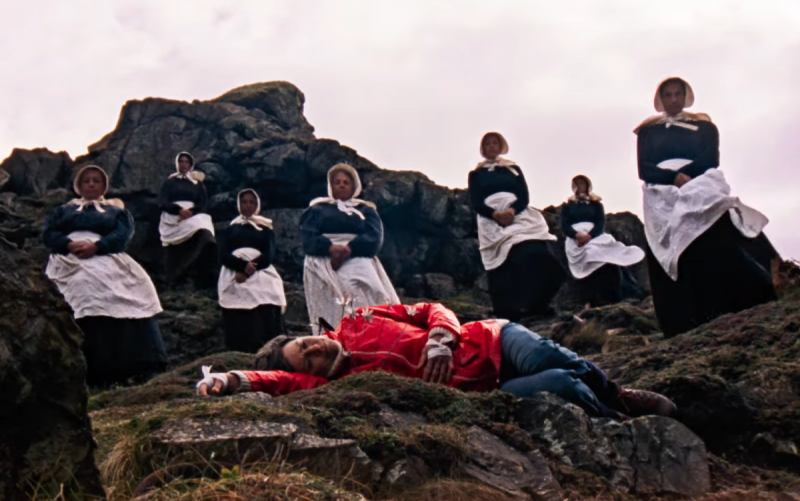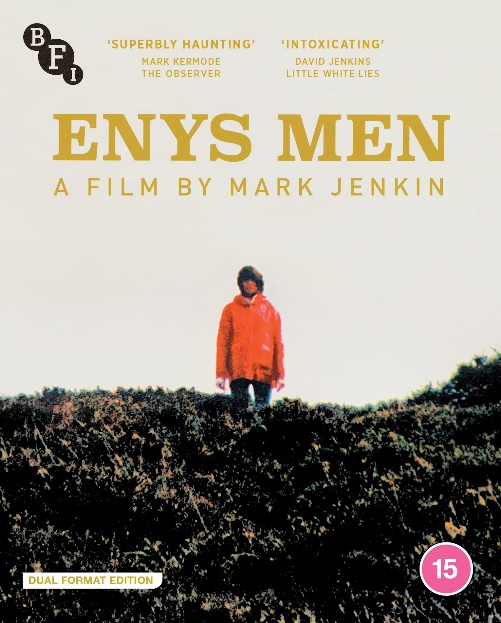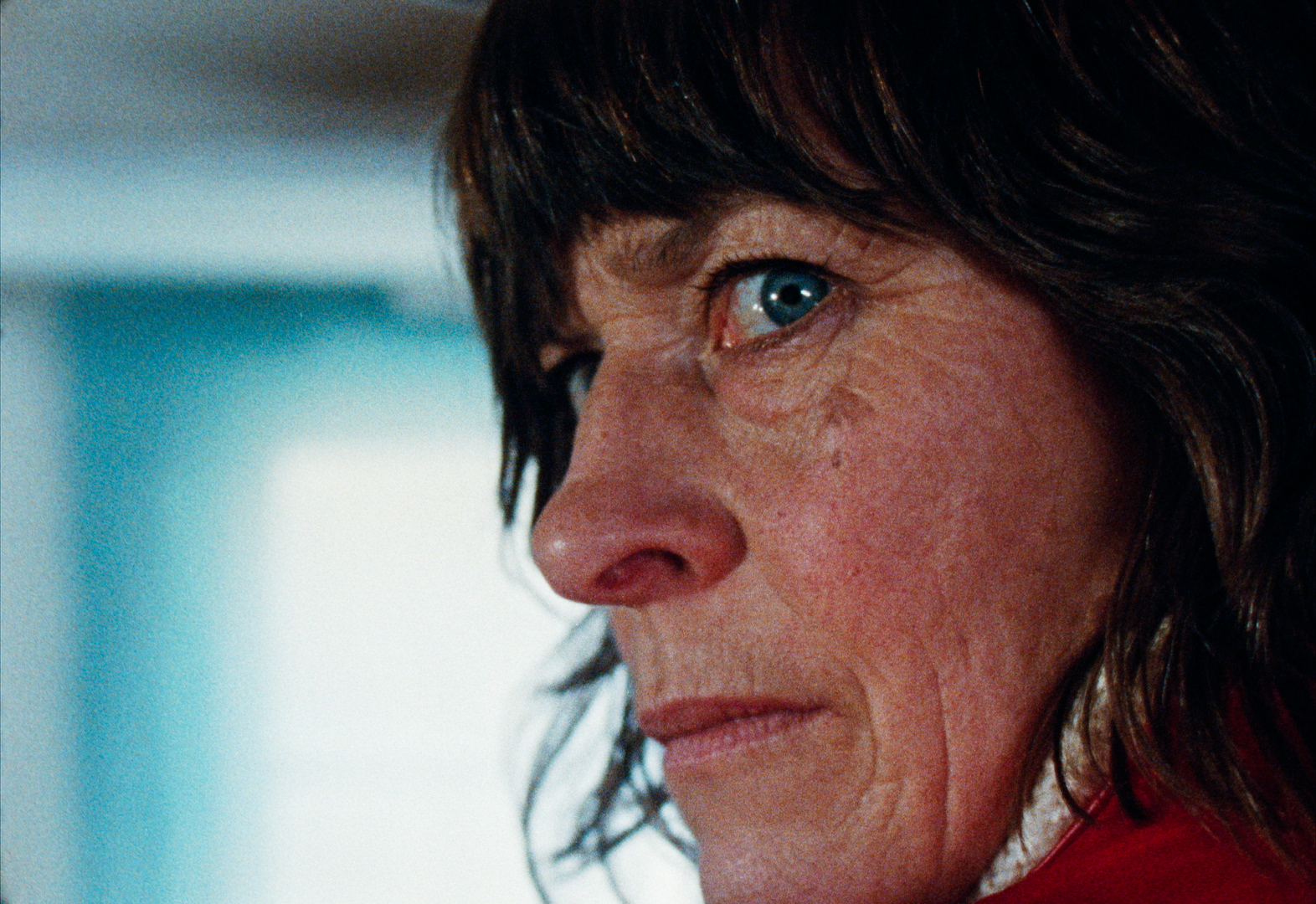DVD/Blu-ray: Enys Men | reviews, news & interviews
DVD/Blu-ray: Enys Men
DVD/Blu-ray: Enys Men
Mark Jenkin's Bait follow-up is an avant-garde Cornish myth of unquiet land and loss

In Mark Jenkin’s haunted Cornwall, time warps and bends. He is a child of Nic Roeg’s Seventies masterworks (Walkabout, Don’t Look Now, The Man Who Fell To Earth), whose kaleidoscopic slivering of time expressed an elliptical, sensual mind. Jenkin too has built his own time and space with self-described “seemingly crazy” antique techniques, limiting him to clockwork, 16mm film and post-synch sound.
In this follow-up to his debut, Bait, a ship sunk in 1897's flotsam bobs into 1973, premonitory of a new sinking, remembered on a crackling radio report from now. The otherwise nameless volunteer (Mary Woodvine) meanwhile lives alone on an island in ‘73, recording a rare flower’s daily condition, with the radio and a boatman’s supplies her only mainland contact. At night she reads Teddy Goldsmith and Robert Allen’s A Blueprint for Survival (1972), an early eco-warning placing us in the apocalyptic terrain of TV’s Survivors (1975-77), Doom Watch (1970-72) and the Dr Who serial The Green Death (1973). The eerie ethno-mysticism of Jenkin influences The Shout (1978), The Last Wave (1977) and Walkabout (1971) also lie in Enys Men’s unquiet soil, where the films’ Aboriginal earth-magic becomes Cornish.
 Woodvine looks capably solitary and strong, weathered and at one with the landscape. The volunteer’s isolation and steady concentration sets a deliberate, incremental pace. Then lichen appears on the flowers like poison, spreading to the livid scar on her stomach. As Jenkin explains in an elegant commentary with Mark Kermode which otherwise insists on mystery, she soon slips into a mirror-image of her house, and her mindscape shifts.
Woodvine looks capably solitary and strong, weathered and at one with the landscape. The volunteer’s isolation and steady concentration sets a deliberate, incremental pace. Then lichen appears on the flowers like poison, spreading to the livid scar on her stomach. As Jenkin explains in an elegant commentary with Mark Kermode which otherwise insists on mystery, she soon slips into a mirror-image of her house, and her mindscape shifts.
Bait hit the hot topics of gentrification and second-homes, property imperialism which cost its fisherman protagonist his home and boat, finding an unsuspected, ready audience as Jenkin toured it to cinemas all around these isles, but particularly Cornwall. Enys Men lacks that hook, making its abstraction more forbidding. Its Cornish themes are sunk just as deep, in a tin mine whose miners rise up and lifeboatmen dashed on rocks, violent history also infecting the volunteer’s scar. An ancient, healing hymn sung by a ghost vicar (John Woodvine) makes this widespread, culturally profound loss cohere.
There is no plot, really, but seams of connection between fragments of time, found in a woman’s psyche and a roiling, vivid landscape. Jenkin favours form over content, and the physical material of the film itself breathes and blurs as it’s exposed, capturing the wild land’s deep-hued richness. Enys Men “isn’t quite a horror film”, Jenkin notes. Watching it as one just disappoints, one freaky, shuddering scene aside. It doesn’t grip as Bait did either, but enigmas thread through it, incomplete codes which can’t be fully cracked. It’s an arthouse, avant-garde Cornish myth, a bleeding-red jigsaw falling into place further with each viewing.
Enys Men “isn’t quite a horror film”, Jenkin notes. Watching it as one just disappoints, one freaky, shuddering scene aside. It doesn’t grip as Bait did either, but enigmas thread through it, incomplete codes which can’t be fully cracked. It’s an arthouse, avant-garde Cornish myth, a bleeding-red jigsaw falling into place further with each viewing.
Extras on this BFI dual-format release include a Children’s Film Foundation film, Haunters of the Deep (1984), sharing West Cornwall locations and a haunted tin mine with Enys Men, and The Duchy of Cornwall (1938), a travel short evoking the county’s Mediterranean forebears, storm-lashed iron coast, wrestling rituals, tin mines and tourists. The modest, personable Jenkin provides audio diaries as lockdown postpones Enys Men and a third film is written, considers sound with Peter Strickland and is interviewed with Woodvine.
The future of Arts Journalism
You can stop theartsdesk.com closing!
We urgently need financing to survive. Our fundraising drive has thus far raised £49,000 but we need to reach £100,000 or we will be forced to close. Please contribute here: https://gofund.me/c3f6033d
And if you can forward this information to anyone who might assist, we’d be grateful.

Subscribe to theartsdesk.com
Thank you for continuing to read our work on theartsdesk.com. For unlimited access to every article in its entirety, including our archive of more than 15,000 pieces, we're asking for £5 per month or £40 per year. We feel it's a very good deal, and hope you do too.
To take a subscription now simply click here.
And if you're looking for that extra gift for a friend or family member, why not treat them to a theartsdesk.com gift subscription?
more Film
 After the Hunt review - muddled #MeToo provocation
Julia Roberts excels despite misfiring drama
After the Hunt review - muddled #MeToo provocation
Julia Roberts excels despite misfiring drama
 London Film Festival 2025 - Bradley Cooper channels John Bishop, the Boss goes to Nebraska, and a French pandemic
... not to mention Kristen Stewart's directing debut and a punchy prison drama
London Film Festival 2025 - Bradley Cooper channels John Bishop, the Boss goes to Nebraska, and a French pandemic
... not to mention Kristen Stewart's directing debut and a punchy prison drama
 Ballad of a Small Player review - Colin Farrell's all in as a gambler down on his luck
Conclave director Edward Berger swaps the Vatican for Asia's sin city
Ballad of a Small Player review - Colin Farrell's all in as a gambler down on his luck
Conclave director Edward Berger swaps the Vatican for Asia's sin city
 London Film Festival - from paranoia in Brazil and Iran, to light relief in New York and Tuscany
'Jay Kelly' disappoints, 'It Was Just an Accident' doesn't
London Film Festival - from paranoia in Brazil and Iran, to light relief in New York and Tuscany
'Jay Kelly' disappoints, 'It Was Just an Accident' doesn't
 Iron Ladies review - working-class heroines of the Miners' Strike
Documentary salutes the staunch women who fought Thatcher's pit closures
Iron Ladies review - working-class heroines of the Miners' Strike
Documentary salutes the staunch women who fought Thatcher's pit closures
 Blu-ray: The Man in the White Suit
Ealing Studios' prescient black comedy, as sharp as ever
Blu-ray: The Man in the White Suit
Ealing Studios' prescient black comedy, as sharp as ever
 The Woman in Cabin 10 review - Scandi noir meets Agatha Christie on a superyacht
Reason goes overboard on a seagoing mystery thriller
The Woman in Cabin 10 review - Scandi noir meets Agatha Christie on a superyacht
Reason goes overboard on a seagoing mystery thriller
 London Film Festival 2025 - crime, punishment, pop stars and shrinks
Daniel Craig investigates, Jodie Foster speaks French and Colin Farrell has a gambling habit
London Film Festival 2025 - crime, punishment, pop stars and shrinks
Daniel Craig investigates, Jodie Foster speaks French and Colin Farrell has a gambling habit
 I Swear review - taking stock of Tourette's
A sharp and moving tale of cuss-words and tics
I Swear review - taking stock of Tourette's
A sharp and moving tale of cuss-words and tics
 A House of Dynamite review - the final countdown
Kathryn Bigelow's cautionary tale sets the nuclear clock ticking again
A House of Dynamite review - the final countdown
Kathryn Bigelow's cautionary tale sets the nuclear clock ticking again
 theartsdesk Q&A: Idris Elba on playing a US President faced with a missile crisis in 'A House of Dynamite'
The star talks about Presidential decision-making when millions of lives are imperilled
theartsdesk Q&A: Idris Elba on playing a US President faced with a missile crisis in 'A House of Dynamite'
The star talks about Presidential decision-making when millions of lives are imperilled

Add comment